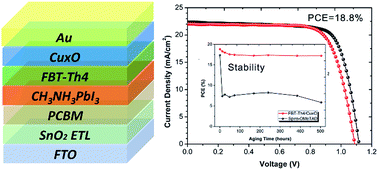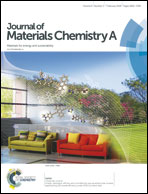An integrated organic–inorganic hole transport layer for efficient and stable perovskite solar cells†
Abstract
Certified power conversion efficiencies (PCEs) of perovskite solar cells (PSCs) have increased to an impressive value of 22.1%. The most efficient perovskite solar cells have the n–i–p device architecture and use 2,2′,7,7′-tetrakis(N,N′-di-p-methoxyphenylamine)-9,9′-spirobifluorene (spiro-OMeTAD) as the hole transport material (HTM). However, there exists microscopic inhomogeneity that is detrimental to the long-term performance of the solar cells, primarily as a result of the hygroscopicity of the lithium bis((trifluomethyl)sulfonyl)amide (LiTFSI) dopant. Here, we report a strategy for reducing heterogeneity by using an organic–inorganic integrated hole transport layer (HTL) composed of the solution-processable conjugated polymer FBT-Th4 and copper oxide (CuxO). The optimized PSCs show significant performance enhancement with power conversion efficiency up to 18.85% from a reverse voltage scan and a stabilized champion efficiency of 18.24% with negligible hysteresis. Moreover, we observe a significant enhancement of the long-term stability of perovskite solar cells under a high humidity of 70–80% in air.



 Please wait while we load your content...
Please wait while we load your content...